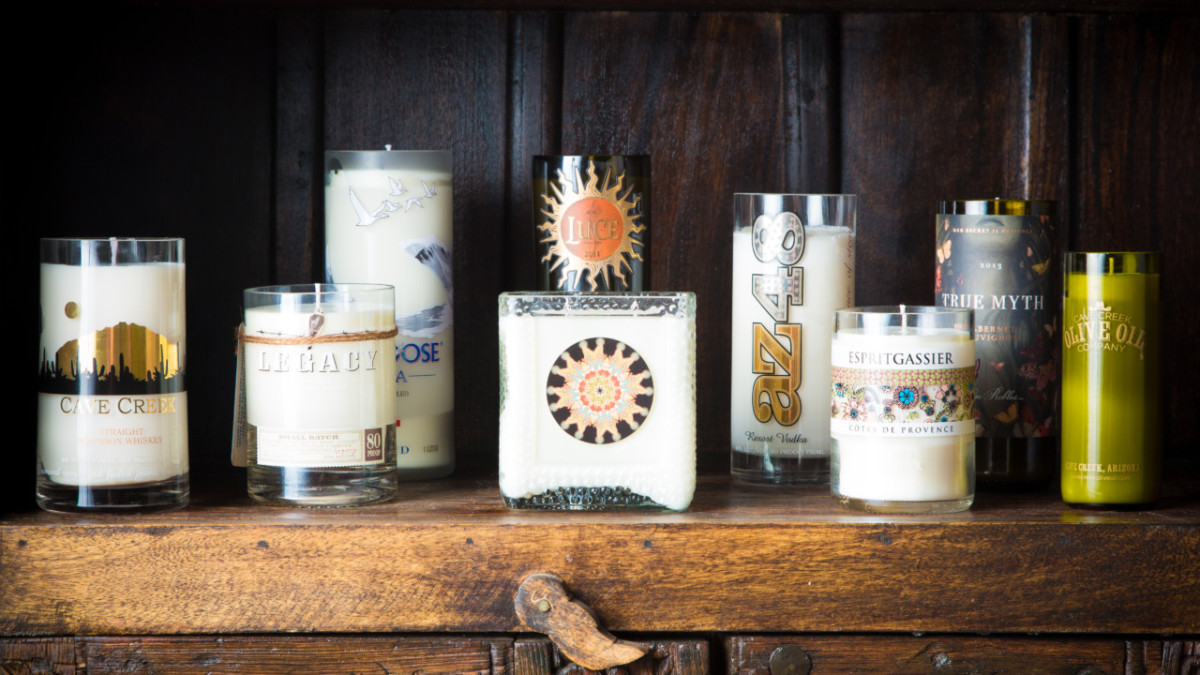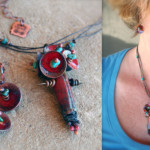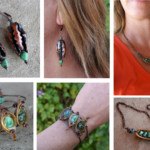Guardians of the Garbage: Local artists breathe life into life’s remnants

Writer Lara Piu
[dropcap]U[/dropcap]sed glass containers, old T-shirts, discarded window frames and empty aluminum cans may be garbage to some, and recycling to others. But for four Valley upcycle artists, life’s remnants inspire the creation of something new.
Debbie Zapatka
A longtime upcycler, Debbie began making jewelry 11 years ago. Her love of metal sculpturing sparked it — and so did a friend.
“When I moved from Chicago to Arizona, I no longer had a studio space where I could make large sculptures, so I started making sculptures on a much smaller scale using metal scraps,” says Debbie. “I mentioned to a friend at work that I preferred to find my material for creating art rather than to purchase it. The next day, he came in with a bag of seed pods from a tree in his yard and challenged me to create something with them.”
Completely made from recycled metals, Debbie now makes, among other things, jewelry with seed pods.
“I have always been inspired by nature and the natural beauty of aging objects,” she says. “I hope my work reflects that by melding nature, metal and other objects together into an organic piece of art.”
An upcycle artist long before it was a thing, Debbie has also painted art on old wood since 1997.
Why upcycling?
“It’s cheaper than buying canvas or manufactured bezels. For me, it also stimulates creativity.” Debbie says. “I love the challenge of looking at an object and figuring out a way to make it into something else. I also love the reaction of others when they recognize what the original object was. I hope it encourages others to think creatively and maybe develop their own creative projects.”
Gary Brown
Like many great things, Gary’s work was born of necessity.
“Most of my first pieces were made for my home,” he says. “I was unsatisfied with the quality and design of the furniture available in retail shops. I found that reclaimed materials, along with some creativity, offered endless possibilities when it came to furniture. Initially, failure was more common than success. The image in my mind did not always find its way to the work bench. I also learned that with any passion, I can recognize it or suppress it. The inspiration to start creating has always been there. I recognized that creating multimedia furniture paralleled my skill set and creative drive.”
For more than 15 years, Gary continued to design and craft custom furniture casually, primarily for family and friends. Two years ago, he opened BalanceCraft, featuring furniture and home decor made from reclaimed materials, most salvaged locally. The materials, like barnwood, live-edge hardwood and salvaged steel, inspire him.
“I have found that getting my hands on the material is key,” he says. “Feeling the weight, texture and behavior of a material has often provided direction on the function and vibe of the piece. I love walking around scrap metal and industrial yards. Vintage machinery has beautiful lines and quality craftsmanship that is unmatched in today’s assembly lines. I also find inspiration in my travels. I am fascinated by Greene and Greene architecture and furniture. I am also intrigued by the complexity and precision found inside a vehicle transmission and motor. Old farm equipment has often inspired designs for today. And if I am lucky enough, I may get the opportunity to talk with the farmer who operated that equipment.”
Why upcycling?
“Upcycling seems to be a natural progression in consumer behavior,” Gary says. “It provides a balance between responsibility and quality. Material left over from the Industrial Revolution tended to be of a higher quality. If it has survived this long, it will easily find another purpose. Barn beams and barnwood have a patina and character that cannot be reproduced. If you like the look and feel of these materials, upcycling is the only option.
Kari Castillo
Kari’s work is inspired by her love of all things vintage. The junk lover first made pillows and curtains for her home. Later, she used mud cloth and sold her pillows at Sweet Salvage. Last May, she fell in love with a vintage indigo batik fabric from Africa on a picking trip in California.
“I knew it would be great for the pillows, but I knew there must be more I can do,” she says. “I immediately thought of kimonos and ponchos. I am inspired by the fabrics and the textiles, just the look and feel of it all. I try to maintain the integrity of the fabric so that each piece has its own unique character.”
Kari wasted no time and expanded her line with the new-to-her fabric. The response was overwhelming. Now she creates ponchos, kimonos, drape-front vests, infinity scarves, pillows, stools and more.
“My items are intended to enhance a space and instill soul into a room,” she adds.
The color of the batik provides additional inspiration.
“Because the color of the fabric is blue and that is the color that represents autism, it was important for us to continue to raise awareness for the cause,” she says. “My son, Sterling, is autistic — he is 16 but was diagnosed at the age of 5. We are driven to creating acceptance and understanding for the special needs community.”
A portion of blue items sold are donated to Autism Speaks.
Why upcycling?
“The history and the culture inspires me,” Kari says. “Also, each piece is an individual and has its own identity. That’s what is fun about it. I like to see where the fabric takes me. Each piece is truly one of a kind; I couldn’t duplicate it if I wanted to. Inch by inch, they are different, and each piece I create inspires me in its own way.
etsy.com/shop/renegaderemnants
Sue Calabrese
A longtime candle lover, Sue was first inspired when she ran across artists upcycling glass for a variety of purposes in California in 2013.
“I had always loved candles and was buying them all the time,” says Sue. “When I saw the artists using recycled bottles, I thought candles could work, too.”
When she returned from the trip, she began pouring candles in used glass containers: bourbon bottles, wine bottles and nearly any bottle that she could get her hands on. She made small batches of candles in her Carefree kitchen, using the same process then as she does now. After she wraps each bottle to protect the label, the bottles are cut with a wet saw. Then, she polishes the glass and fills it with wax. Her materials are sourced from friends, family and recycling partners like Brix, Cartwright’s and Tonto Bar & Grill, which save bottles for her to use.
Merely six months later, she landed her first retail gig at Daisy Blue in North Scottsdale. Now her candles are sold at eight stores in Arizona and California, and her biggest problem is keeping up.
“We can’t keep them in stock,” says Sue. “They sell very well.”
She also now has a home studio dedicated to candle making in Cave Creek. Besides being green by way of glass, the candle wax is eco-friendly, made with 100 percent soy wax that is free of petroleum, pesticides, herbicides and GMOs. The U.S.-grown soybean is biodegradable, and because it burns clean of soot or chemicals, the candles are designed to burn slower and last longer. The wicks are 100 percent cotton and the essential oils used to scent the wax are phthalate-free.
“It’s about as pure as it gets,” she jokes.
Sue is inspired by the variety that her medium brings.
“We work with a variety of types, sizes and shapes, and you never know what you’re going to get,” she says. “It’s exciting to see the finished product and fun when it turns out better than we thought.”
Why upcycling?
“I feel like I’m doing my part to protect the environment the best I can,” says Sue. “I’ve always liked things that are green and good for the environment. It’s all about repurposing the bottle and creating something artistic and fun.”







